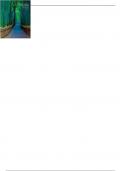,Chapter 1
MULTIPLE CHOICE
1. Walter Cannon’s term ____ refers to the biological self-regulation process that enables an organism to
adapt to life’s demands.
a. dynamic organism feedback c. homeostasis
b. physiological stress reactions d. fight-or-flight reaction
ANS: C PTS: 1 REF: What is Stress?
2. Selye did not believe that all stress was negative. In fact, he referred to negative stress as ____ and
coined the term ____ to refer to positive stress.
a. distress, eustress c. threat, challenge
b. eustress, uplift d. distress, wellness
ANS: A PTS: 1 REF: What is Stress?
3. The idea that chronic stressors can be detrimental to one’s health was formalized by the stress research
pioneer Hans Selye, who proposed a three stage model of chronic stress called the General Adaptation
Syndrome (GAS). The three stages of the GAS are ____.
a. fight-or-flight, alarm, and resistance
b. alarm, exhaustion, and relaxation
c. fight-or-flight, resistance, and exhaustion
d. alarm, resistance, and exhaustion
ANS: D PTS: 1 REF: What is Stress?
4. Holmes and Rahe created an instrument called the Social Readjustment Rating Scale (SRRS) to
measure life change events. In their model of stress, higher life change event scores for the last six
months to a year indicate a person has a greater likelihood of ____.
a. suicidal behavior c. living a shorter lifespan
b. developing an illness d. pessimism
ANS: B PTS: 1 REF: What is Stress?
5. In the ____ model of health, the sick person may be seen as a victim but may also be viewed as having
contributed to the illness through engaging in unhealthy behaviors.
a. biomedical c. psychosomatic
b. biopsychosocial d. behavioral
ANS: B PTS: 1 REF: What is Health?
6. ____ , inspired by Sigmund Freud’s idea that repressed memories and intrapsychic conflict can lead to
somatic conversions expressed as physical symptoms, broke rank with the conventional medical
thinking of the time and became one of the first medical areas to challenge the mind-body duality
aspect of the biomedical model.
, a. Psychoanalysis
b. Illness prevention
c. Somatic interpretation of physical agents
d. Psychosomatic medicine
ANS: D PTS: 1 REF: What is Health?
7. Persons with ____ are more motivated to engage in health-promoting behaviors like physical exercise
and avoid health-destructive behaviors like tobacco smoking.
a. strong SOCs c. positive SOCs
b. weak SOCs d. balanced SOCs
ANS: A PTS: 1 REF: Antonovsky's Salutogenic Model
8. Stressors produce ____ changes that can be detrimental to both our physical and psychological health.
a. cognitive, emotional, physiological, and behavioral
b. cognitive, genetic, and psychological
c. physiological, pathogenic, and behavioral
d. genetic, physiological, behavioral, and cognitive
ANS: A PTS: 1 REF: The Impact of Stress on Health and Performance
9. The autonomic nervous system is responsible for enervating the organ systems of the body, and with a
few important exceptions (e.g., organs of the gastrointestinal system), its ____ branch is generally
responsible for the arousal response of these organs.
a. parasympathetic c. sympathetic
b. sensory d. primary physiological
ANS: C PTS: 1 REF: The Physiology of Stress
10. Sympathetic nervous system activation in concert with adrenal gland catecholamine secretions such as
____ (known also as adrenalin) and ____ (known also as noradrenalin) prime the body to physically
fight off threats to safety or to flee from these threats through such activities as increasing cardiac
output and blood pressure that transit additional blood to the brain and large muscles of the body
where the blood is most acutely needed.
a. cortisol, norepinephrine c. cortisol, glucocorticoids
b. epinephrine, norepinephrine d. ephedrine, norephedrine
ANS: B PTS: 1 REF: The Physiology of Stress
11. The ____ model suggests that many illnesses may result from an interaction of biology and the
environment.
a. diathesis-stress c. bio-eco
b. General Adaptation Syndrome d. multi-axial stressor
ANS: A PTS: 1 REF: The Physiology of Stress
12. Cannon and Selye paved the way for research in fields like psychoendocrinology. What do
psychoendocrinologists examine?
, a. The effects of psychological processes on endocrine dysfunction
b. The effects of endocrine dysfunction on mental processes
c. The relationship between stress levels and endocrine function
d. The relationship between psychological processes and endocrine function
ANS: D PTS: 1 REF: The Physiology of Stress
13. Following an adaptive fight-or-flight reaction, the homeostatic mechanisms return the body back to
normal ____.
a. baseline c. homeostatic rest
b. homeostasis d. pre-reactive functioning
ANS: A PTS: 1 REF: The Physiology of Stress
14. During the fight-or-flight response, hormones such as epinephrine, norepinephrine, and cortisol are
secreted from the hormonal system to stimulate the release of ____.
a. awareness-altering hormones
b. energy for action
c. neurotransmitters to stimulate cognitive activity
d. oxygen to the muscles
ANS: B PTS: 1 REF: The Physiology of Stress
15. Based on various physical stressors, Hans Selye determined through autopsies that the rats in his
experiments experienced common physiological patterns of change over time, such as reductions in
the size of the thymus and lymph glands, enlarged adrenal cortexes, and ulcerated stomachs. He
described these physiological changes as stress reactions. They were characterized as ____ because
they represented common patterns to a host of different stressors.
a. generic responses c. physiological responses
b. alarm responses d. non-specific responses
ANS: D PTS: 1 REF: The Physiology of Stress
16. Most modern biological models of stress build on the work of Cannon and Selye by focusing on the
measurement of stress reactions through ____ (i.e., epinephrine and norepinephrine) and cortisol
excretions.
a. noradrenaline c. catecholamine
b. adrenaline d. dopamine
ANS: C PTS: 1 REF: The Physiology of Stress
17. The less our perceived amount of ____ in relation to a stressor, the more stressful we perceive the
event to be.
a. understanding c. orientation
b. control d. coping
ANS: B PTS: 1 REF: The Psychology of Stress




